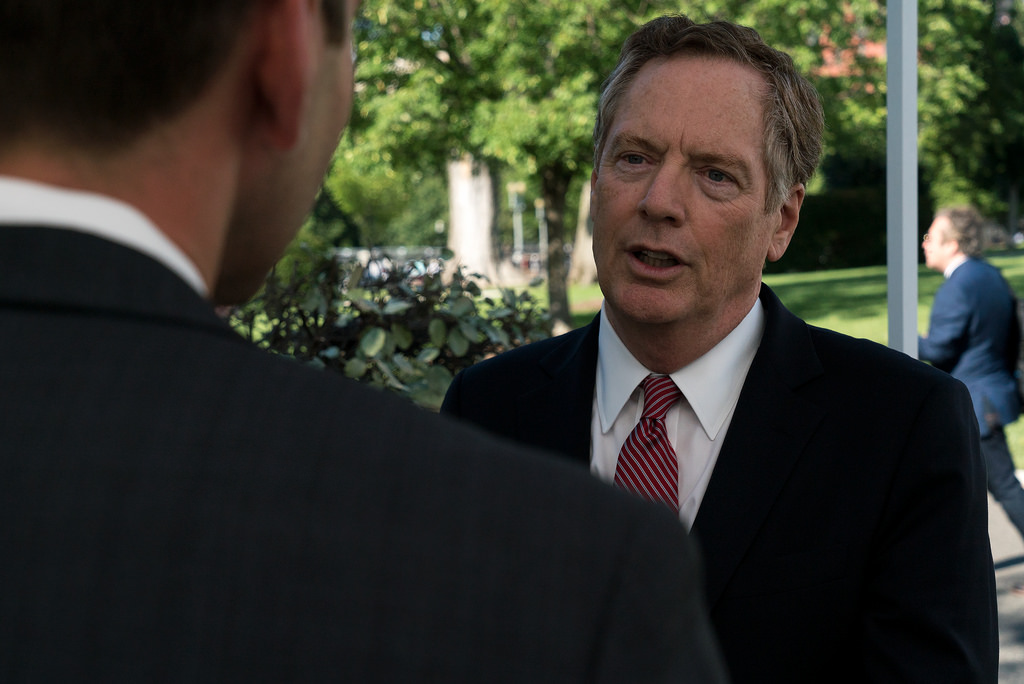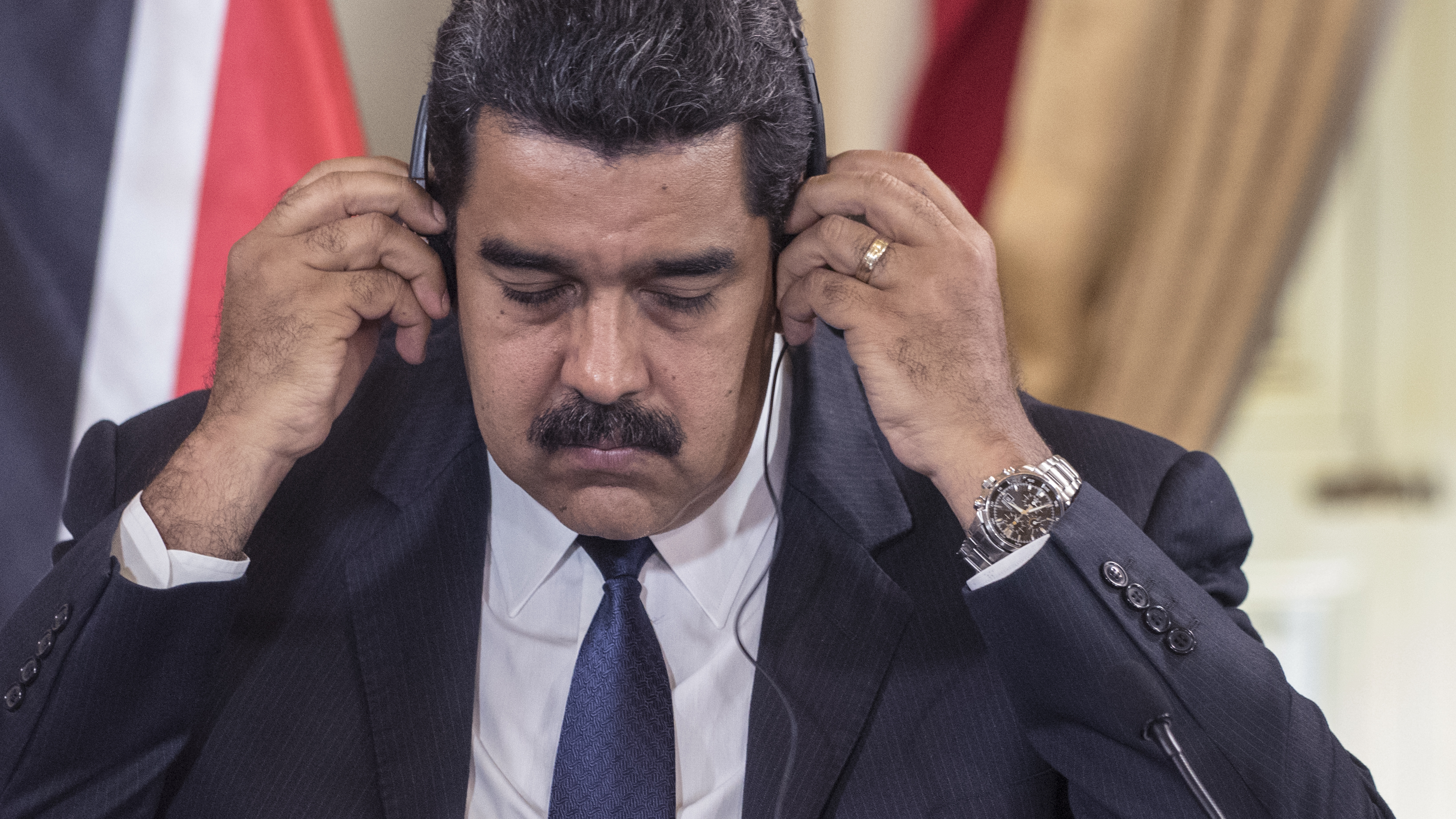America Trades Down: The Legal Consequences of President Trump's Tariffs
Economic welfare and national security are sewn together with a tight stitch, and the president is pulling on the seam. His decision to impose tariffs on steel and aluminum imports pursuant to Section 232 of the Trade Expansion Act carries repercussions both for the United States and for international trade.

Economic welfare and national security are sewn together with a tight stitch, and the president is pulling on the seam. His decision to impose tariffs on steel and aluminum imports pursuant to Section 232 of the Trade Expansion Act carries repercussions both for the United States and for international trade.
In April 2017, President Trump requested that the Commerce Department review the national security risk posed by steel and aluminum imports. On March 8, after the conclusion of the investigation, Trump signed two proclamations concurring with the department’s findings that the imports threaten to impair national security.
More importantly, these proclamations also made official Trump’s promised tariffs on imported steel and aluminum. The tariffs go into effect on March 23, and U.S. Trade Representative Robert Lighthizer will negotiate which states will be excluded between now and then. The president has already said that Canada and Mexico will be temporarily exempt from the tariffs while North American Free Trade Agreement negotiations are ongoing. The EU (America’s second-largest steel source) and Japan (its eighth-largest) also seem to be on the list: On March 10, Lighthizer met with the European Trade Commissioner Cecilia Malmstrom and the Japanese Trade Minister Hiroshige Seko.
As Clark Packard and Megan Reiss wrote on Lawfare, the Commerce Department’s investigation and subsequent findings are only dubiously connected to national security, both from an economic and a legal perspective. Robert Williams has also argued that the department’s recommendation sets a dangerous precedent that will open the United States up to reciprocal measures as other states begin to place tariffs on U.S. products in the name of their own national security. We don’t intend to repeat these critiques and the numerous others—though that isn’t to say that we disagree with them. Instead, this piece will highlight a different facet of the tariffs issue: its legal consequences.
Under what legal authority is the president acting?
While the president seems to have made this decision off the cuff—Jonathan Swan writes for Axios that though the Commerce Department recommended a 24 percent steel tariff, the president reportedly chose 25 percent because it “sounded better”—the decision was only the finishing touch on nine months of statutory process and two agency investigations. Section 232 allows the executive branch, through proper process, to take action to protect the country from imports that threaten national security. Section 232(b) outlines the process through which the commerce secretary determines the national security effects of a particular import. If the Commerce Department finds that “an article is being imported into the United States in such quantities or under such circumstances as to threaten or impair the national security,” the president has the option to agree or disagree with the department’s conclusion. If she agrees, she may “determine the nature and duration of the action that ... must be taken to adjust the imports of the article and its derivatives so that such imports will not threaten to impair the national security.” When the commerce secretary begins an investigation—either at the request of a head of department, an interested party, or of her own volition—she must first give notice to the secretary of defense. Commerce then has 270 days to submit a report of its findings to the president. In the meantime, the secretary must consult with the defense secretary and other “appropriate officers of the United States.” She may also consult other interested parties outside of government. Upon receipt of the report, the president has 90 days to determine whether she agrees with the Commerce finding. She must then submit a report to Congress outlining her rationale within 30 days of that determination.
In this case, Secretary of Commerce Wilbur Ross initiated the department’s investigation on April 19 and sent a notification to Defense Secretary James Mattis that same day. On April 21, the Commerce Department published a notice in the Federal Register announcing the investigation, an associated public comment period, and a public hearing to be held on May 24. According to the department’s final report, steel investigators also consulted the Departments of State, Treasury, Interior and Homeland Security, as well as the International Trade Commission (ITC) and Office of the U.S. Trade Representative (USTR). The department released its final steel report on Jan. 11. The aluminum report followed the steel report’s tracks, about a week behind at each step.
But the manner in which the president made his announcement threw normal process out the window. Reports indicate that Trump’s announcement caught the Departments of State, Treasury and Defense by surprise. Once the proclamation is signed, the government has a 15-day window for implementation. But the process of implementing new tariffs involves quite a bit of work: determining the scope of the measures, adjusting the appropriate Harmonized Tariff Schedule codes (the primary system of tariff classifications for goods) as identified in the proclamation, negotiating and dealing with any exemptions, and notifying U.S. Customs and Border Protection along with any relevant importers. CNN reports that even some White House aides working on trade policy didn’t see the announcement coming. So whether other stakeholders—like the ITC and the Commerce Department—are fully prepared to execute the president’s plan is a question still hungry for an answer.
Will there be a domestic legal challenge?
Probably. There is far too much money tied up in the steel market to avoid litigation. But the legal theory upon which a domestic challenge might be brought is not immediately clear and there has not been much litigation concerning Section 232 considering how rarely it has been employed.
Possible claims include a challenge to the statute itself that would focus on its delegation of Congress’s authority to the executive. But the Supreme Court decided in a 1976 case that Section 232 is a proper delegation of power to the president.
The basis for a challenge to the president’s decision under the Administrative Procedure Act is also shakey. In 2010, the Federal Circuit upheld the Court of International Trade decision in an APA challenge to the president’s proclamation adopting the ITC’s suggested modifications to tariffs. The court found that the ITC’s recommendations were not “final” and the presidential proclamation did not constitute “agency action” for the purposes of the APA. The Commerce Department’s steel and aluminum findings and Trump’s subsequent executive action mirror the facts of that case such that a judicial remedy may well be out of reach. A 1982 decision by the Court of International Trade concerning Section 201 of the Trade Expansion Act elucidates that the president’s action “being authorized by the statute on which he relied, his motives, his reasoning, his finding of facts requiring the action, and his judgment are immune from judicial scrutiny.” There may be an opening here because court could consider whether the president’s action of levying tariffs was authorized by Section 232, but the language of the statute is express in that authorization and, beyond that, his reasoning behind the decision is unlikely to be scrutinized under the same test.
And Section 232 itself provides no remedy, legislative or judicial, for actions taken against goods other than petroleum imports. Interested observers should pay close attention to the legal claims that surface in the aftermath of this decision.
Will there be an international legal challenge?
Almost certainly. Dispute resolution at the World Trade Organization level is easier to visualize. The General Agreement on Tariffs and Trade (GATT) obligates members to adhere to a complex set of trade arrangements and schedules governed by the central principles of trade without discrimination: “most-favored nation” under Article I of the treaty, and “national treatment” under Article III. That means every signatory nation must treat goods coming from other members equally—giving all countries the same treatment as one’s most-favored trade partner—and that imports may be treated no differently than a member nation’s domestic products, subject to a few exceptions. Free-trade agreements are one category of common exceptions. But a more unusual exception has been discussed widely in popular coverage of the proposed Section 232 steel and aluminium tariffs: the GATT’s Article XXI exception for national security, which allows member nations to take actions to protect their national security in specific realms (i.e., regarding fissionable materials; relating to the traffic in arms, ammunition and implements of war; actions taken in war or other emergency in international relations; or to prevent the abrogation of obligations under the United Nations Charter).
Countries will likely resort to the dispute settlement mechanism of the WTO to address the impending steel and aluminum import tariffs. The EU has said as much: It is prepared to file a case in the WTO, although it has held off in anticipation of negotiating an exemption. In all likelihood, the U.S. will invoke Article XXI in its defense and emphasize the provision’s deference to the member’s judgment of national security importance. But that provision of the GATT has been invoked so rarely that there is no telling how the panel or the appellate body will deal with an Article XXI claim in this case. Furthermore, it’s important to remember that a legal determination from the WTO may take years. (The Peterson Institute for International Economics has a primer on remedies and retaliation in the WTO system.)
In addition to the GATT claim, the EU threw a curve ball on March 7 by suggesting that it would also levy retaliatory safeguard measures—that is, protective trade measures authorized under Article XIX of the GATT and the Safeguards Agreement. There are two safeguard angles that the EU may take. First, it may interpret the U.S.’s tariffs as safeguards and respond under the authority of Article 8 of the Safeguards Agreement. And second, it may levy its own safeguards against the influx of steel into the EU market.
But the U.S. hasn’t claimed the tariffs are a safeguard. And even if the WTO reinterpreted them as such—which its precedent allows—the procedural history and economic facts probably wouldn’t support that conclusion. If the U.S. was de facto levying a safeguard, it would have had to have acted in response to an agressive uptick in steel and aluminum imports. Morevoer, a proper safeguard would have had to meet substantial procedural requirements—none of which were adhered to in this case.
Nevertheless, European Trade Commissioner Cecilia Malmstrom said on March 7 that the EU believes that the new tariffs are an “economic safeguard measure in disguise, not a national security measure … that means that the EU is entitled to make use of a WTO safeguard agreement to rebalance benefits that we have given to the U.S. in the past.”
Article 8 of the Safeguards Agreement says there should be consultations between the country levying the safeguard and the exporting country impacted. If the parties don’t reach an agreement within 30 days—a requirement automatically fulfilled because consultations aren’t taking place—the exporting member country is allowed to apply trade restrictions that amount to “substantially equivalent concessions or other obligations under GATT ... to the trade of the member applying the safeguard member.” This is what Malmstrom has said the EU will do if it’s hit with Trump’s tariffs.
The EU has also suggested that it will impose its own safeguards in response to the injury that its market will suffer from the influx of steel that would otherwise have gone to the United States. That said, it too would have to obey the complex procedures necessary for justifying safeguard measures.
If the WTO panel accepts that the EU’s case that the tariffs constitute safeguards, there is precedent for a decision against the United States. In 2003, the WTO ruled against American safeguard measures on certain steel-product imports. The appellate body found that the United States had violated a number of GATT and Safeguard Agreements provisions. Specifically, the U.S. had, among other violations, provided neither a sufficiently “reasoned conclusion” for each safeguard measure (per GATT Article XIX), nor a “reasoned and adequate” explanation of the increased imports determinations for some products (per the Safeguards Agreement’s Articles 2.1 and 3.1).
Although the paths we have outlined are clear should parties opt for strict adherence to dispute resolution norms, Chad Bown, a senior fellow at the Peterson Institute, is less than optimistic (and perhaps more practical) about the fallout of any WTO dispute resolution:
Scenario A has the partner [state] winning the legal case [against the U.S.]. But the global political and economic fallout could be devastating. Trump might react by ignoring the legal ruling, or use it as political motivation to pull the United States from the WTO.
Scenario B has the partner losing. This decision is equally problematic as it opens the door for all countries to impose their own national security protection. Beijing might decide to slap tariffs on the $14 billion of imports of US-grown soybeans that it suddenly discovers are a “threat” to China’s security.
Scenario C has no one bringing such a dispute because they fear the consequences of winning. But that might signal a loss of faith that the rules-based system can still manage trade frictions.
Jennifer Hillman—former general counsel of the United States Trade Representative, former WTO appellate body member, and the former commissioner of the ITC—has said that we are all in “uncharted waters” when it comes to WTO dispute resolution on these grounds. The international dispute resolution outcomes outlined by Bown and the uncertainty underscored by Hillman paint a fraught picture of an undermined WTO regime.
And a weakened WTO is only one of the negative consequences that will likely result from these tariffs. Though the president and commerce secretary have cited China’s steel dumping as a national security danger, China’s imports will not be profoundly affected by these tariffs. In fact, existing trade restrictions already cover almost 94 percent of Chinese steel-product imports. In 2017, China was only the tenth largest supplier of steel to the U.S. and, as other Lawfare contributors have noted, U.S. allies—including Canada, Mexico, Brazil, South Korea, Japan—all export more steel to the United States than China. As Bown argues:
Trump’s claim that the objective is to protect national security is belied by the fact that the new tariffs would impose more than 54 percent of the total trade losses in steel—or $6.1 billion—on US military allies of the European Union, Canada, Japan and South Korea alone.
Much of the world sees these measures as a political affront. Malmstrom called them a “weapon to threaten and intimidate” the EU and emphasized that the EU will “stand up to the bullies.” Even before launching any WTO litigation, the EU has already announced a retaliatory plan that includes levying tariffs against politically sensitive American goods like cranberries, orange juice, peanut butter, bourbon, jeans, and Harley Davidson motorcycles. President Trump has said his new tariffs may be used as a bargaining chip with Canada and Mexico in NAFTA renegotiations—but before the administration even finalized the tariffs, both Canada and Mexico, alongside Brazil and China, were already contemplating retaliatory measures. These countries and others will all be angling for exemptions, but much political damage has already been done.
What’s more, the negotiations will, in and of themselves, raise a number of perplexing legal and political issues. We still don’t know, for example, what concessions the U.S. wants the EU and Japan to make in exchange for a tariff exemption.
What does this all mean?
After working through these complex legal issues, we leave you with two reflections.
First, there is a more important national security narrative worth considering here. Former Secretary of State Cordell Hull wrote in his memoirs that he “could not separate the idea of commerce from the idea of war and peace ... I thereupon came to believe that if we could increase commercial exchanges among nations over lowered trade and tariff barriers and remove international obstacles to trade, we could go a long way toward eliminating war itself.” This perspective may ring too optimistic, but Hull was right that peace is, at some level, inextricably linked to healthy economies. When America undermines international trading norms, creates unnecessary friction with its enemies, and pushes its NATO allies into retaliatiatory positions, it bargains against itself.
Second, both domestic and international dispute resolution mechanisms rest on a certain degree of deference to determinations about national security made by the president and, on an international level, the state. While the case law is thin on the ground, a reading of Section 232 and the GATT Article XXI exception suggests that both provisions allow the president to take dramatic protectionist measures when necessary. This president appears to have flouted that latitude aggressively and recklessly. Quinta Jurecic and Benjamin Wittes have described the common presumption that public officials can be trusted to do their duty in good faith. Trump’s invocation of a dubious national security argument to justify these tariffs raises the same question Americans have been asking since inauguration: Can the world really afford to assume regularity with this president?





